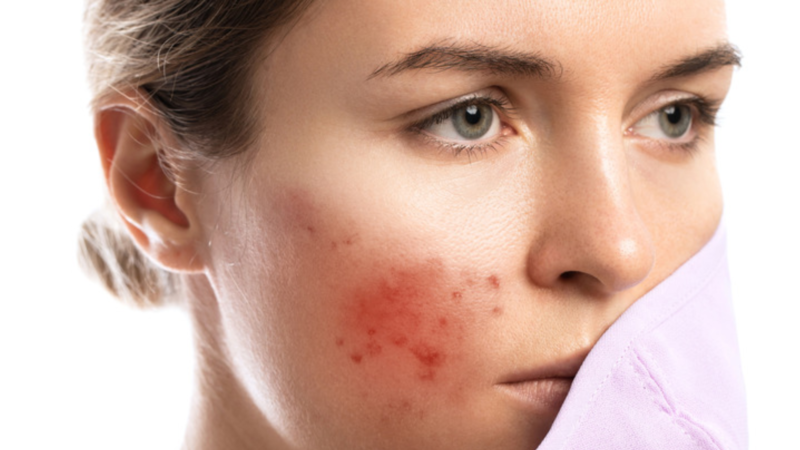Do you have persistent bumps around the hair follicles on your skin? If so, it may be folliculitis. Folliculitis is an inflammation of the hair follicles and can appear as red bumps, pimples, or blisters. It often causes itching and burning and can be painful in some cases. Many factors increase a person’s risk of developing this condition. In this article, we will explore some common signs and symptoms associated with folliculitis and different treatments available to manage its symptoms ranging from home remedies to medications prescribed by a doctor.
Are you suffering from folliculitis?

You may be suffering from a common condition called folliculitis. Folliculitis is an infection of the hair follicles which can cause pain, itchiness, and sometimes even scarring. Understanding what causes it and how to treat it properly is important.
Knowing about this painful condition is very helpful in preventing future outbreaks. Treatments such as antibiotics, topical creams, or laser therapy could help reduce inflammation and make healing easier. Treating folliculitis will also reduce discomfort for those suffering from this problem so that they can get back to living symptom-free!
What is folliculitis, and what causes it to occur?
Folliculitis is a condition that affects hair follicles, causing inflamed, red bumps or pimples. It can occur anywhere on the body where hair grows, but it commonly affects the scalp, neck, armpits, and thighs.
The condition can be caused by various factors, including:
Bacterial or fungal infections
Bacterial and fungal infections are the most common cause of folliculitis. Bacteria, such as staphylococcus aureus, can penetrate hair follicles and create an infection. Fungal infections can also affect hair follicles, resulting in inflamed bumps on the skin.
Allergic reactions
Certain substances or allergens can trigger an allergic reaction in the hair follicles. This can lead to inflammation and red bumps on the skin.
Hormonal imbalances
Hormone imbalances can also be a cause of folliculitis. An imbalance of hormones, such as testosterone or estrogen, can create an environment conducive to infection.
Irritation from shaving or clothing
Shaving can cause irritation and inflammation of hair follicles, leading to folliculitis. Tight clothing can also have a similar effect by trapping sweat and irritating the skin.
Friction from tight clothing or skin rubbing against skin.
Tight clothing can cause skin friction, resulting in hair follicle irritation and inflammation. Skin rubbing against the skin can also irritate the follicles, leading to infection.
Additionally, individuals with weakened immune systems, diabetes, or acne are at an increased risk of developing folliculitis.
How to recognize signs of folliculitis and when to seek medical attention?

Folliculitis is a common skin condition caused by bacteria, fungi, or viruses infecting hair follicles. It may present as:
- Whitehead-like pimples.
- Red bumps.
- Deep painful abscesses.
If you notice any of these symptoms, it’s important to avoid squeezing or picking at them, as this can worsen the situation. Instead, keep the area clean and dry, and wear loose-fitting clothing.
Mild cases of folliculitis may clear up independently, but if you experience fever, swelling, intense pain, or an expanding rash, it may be time to seek a doctor’s opinion. Your healthcare provider may prescribe topical or oral antibiotics or, in some cases, drain abscesses to manage the condition.
Early diagnosis and treatment can prevent serious complications, so seek medical attention if your symptoms persist or worsen. It is best to always speak to your doctor before starting any new treatments for folliculitis.
Learn about the different types of folliculitis, including bacterial, fungal, viral, and chemical.
Folliculitis can occur in various forms, making it important to understand the different types.
- Bacteria in hair follicles cause bacterial folliculitis and can occur anywhere on the body.
- On the other hand, fungal folliculitis is caused by a fungus and is often seen in areas of the body that are warm and moist, such as the scalp.
- Viral folliculitis, while rare, can be caused by a virus such as herpes simplex.
- Finally, chemical folliculitis is the result of a reaction to a chemical substance.
By recognizing the different types of folliculitis, individuals can better identify symptoms and receive the appropriate treatment.
Common treatments for folliculitis and tips for preventing recurrences

Folliculitis, the inflammation of hair follicles, can cause uncomfortable and unsightly bumps on the skin. Thankfully, there are several common treatments available for this condition, such as:
- Antibiotic
- Antifungal cream
- Steroid creams
Preventing recurrences is just as important as treating the symptoms.
Some tips for preventing future outbreaks include:
- Avoiding tight clothing.
- Exfoliating regularly.
- Avoiding sharing personal items such as razors or towels.
Treatment for folliculitis typically involves keeping the affected area clean and dry, applying topical or oral antibiotics or antifungal medications, and avoiding irritating activities or clothing. If left untreated, Folliculitis can lead to hair loss or permanent scarring.
Maintaining good hygiene habits and keeping your skin clean and dry can also help prevent folliculitis. By taking these preventative measures, individuals can reduce the frequency and severity of folliculitis flare-ups.
Folliculitis: Natural Remedies

If you’re looking for at-home solutions, you can try a few options.
- Tea tree oil is known for its antibacterial properties and can be applied directly to the affected area.
- Apple cider vinegar can also be used topically or added to a warm bath.
- Coconut oil and turmeric paste are two more natural remedies with anti-inflammatory properties that could help alleviate the symptoms of folliculitis.
Natural remedies can be beneficial, but it’s important to recognize when medical attention is needed. Keep in mind that these remedies may not work for everyone, and it’s important to seek medical advice if your condition persists or worsens. If symptoms persist or worsen, seek a doctor’s opinion for the most effective treatment options.
How to manage the side effects of folliculitis treatments?
Folliculitis, a common skin condition when hair follicles become inflamed, can be annoying. While several treatments are available to help manage it, many have unwanted side effects. Thankfully, there are ways to deal with these side effects.
For instance, if you experience dry skin or itching due to your treatment, you may want to moisturize your skin regularly with a fragrance-free lotion.
Also, if your treatment causes sensitivity to the sun, be sure to protect your skin by using sunscreen and wearing protective clothing.
With these simple tips and a little patience, you can successfully manage the side effects of folliculitis treatments and be on your way to healthy, clear skin.
Tips for coping with folliculitis
Living with folliculitis can be difficult, but there are things you can do to make the condition more manageable.
- First, stay up-to-date on treatment options and determine which ones work best for you. Speak to your doctor about any concerns or questions that come up.
- Second, practice good hygiene habits to help prevent flare-ups. This includes washing your skin regularly with a mild cleanser and avoiding tight clothing that can trap sweat or irritate the skin.
- Finally, focus on other aspects of your life, such as eating healthily, exercising, and getting enough sleep. These healthy habits can help boost your immune system and reduce stress, which may help keep folliculitis symptoms in check.
Folliculitis is a common skin condition that affects many people. With the right treatment and preventive measures, you can manage your symptoms and reduce the chances of future outbreaks.
Frequently asked questions about folliculitis
Q: What is the most common cause of folliculitis?
A: The most common cause of folliculitis is a bacterial infection, usually from Staphylococcus aureus bacteria.
Q: How long does it take for folliculitis to clear up?
A: The length of time it takes to treat folliculitis can vary depending on the type and severity of your condition. Most mild cases will resolve with proper treatment within a few days or weeks.
Q: Are there any long-term effects of folliculitis?
A: In some cases, folliculitis can lead to hair loss or permanent scarring.
Q: What is the best way to prevent folliculitis?
A: The best way to prevent folliculitis is by maintaining good hygiene practices, such as washing the skin regularly with a mild cleanser and avoiding tight clothing that can trap sweat or irritate the skin.
Q: Can folliculitis be prevented from recurring?
A: Some lifestyle changes can help reduce the risk of recurrent folliculitis flare-ups. These include avoiding irritant contact, staying hydrated, and reducing stress levels.
Conclusion
Folliculitis, though it may be an uncomfortable affliction, is generally not serious. Most cases are mild and can be effectively treated at home with over-the-counter creams or lotions. However, if the condition persists or becomes extreme, see a doctor immediately for proper diagnosis and treatment. Some complications associated with severe folliculitis require more aggressive medicine, such as antibiotics or antimycotic drugs.
It is important to remember that prevention is the best defense against follicular infection. To begin this process of warding off the pain of folliculitis, understand the cause that could trigger it and use measures to avoid contact with triggers such as bacteria in hot tubs. So be wary of potential risks and take necessary precautions to protect your skin’s health.









